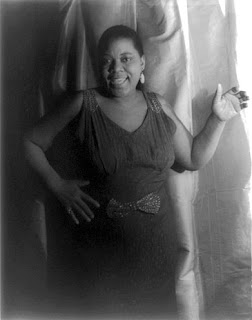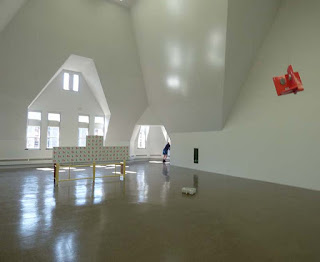Why did the Hairy Who shows attract so much attention back in the 1960’s? All six of them have been partially recreated at the Art Institute of Chicago, so now we can see for ourselves. Not only do the large paintings consistently deliver a wallop, but the six participating artists are quite different from each other - beginning with the two painters who hatched the project at the very beginning: Jim Nutt and Art Green.
Jim Nutt paints human figures that are so uncomfortable they seem to be jumping out of their own skins. Brutally distorted, boogers erupt from the nose; elaborate sores blossom from the flesh. As human beings they are horribly and/or humorously afflicted - yet as paintings they are wonderfully crafted with a variety of materials. The colors bold and beautiful, the designs restless and dynamic; the back painted plexiglass illuminating the room with an eerie glow
Art Green paints ideas. If a human body, or anything else, needs representation, it’s notational rather than expressive. The identity of the objects depicted is obvious: a fiery smokestack, a heavy cannon, an ice cream cone, an automobile tire. The juxtapositions, however, are so puzzling, puzzlement itself appears to be the intended meaning. Our manufactured world is a rent with contradictions. The one piece that delivers that message most explicitly is “Consider the Options, Examine the Facts, Apply the Logic” According to the artist, it depicts Secretary of Defense, Robert McNamara, as he “applied his rational mind to an irrational situation” (the war in Vietnam)
Karl Wirsum, added to group by Don Baum, presents the madcap, boundless energy of a hyperactive ten year old rather than any emotional or philosophical angst. Yet there is nothing careless or juvenile about his work. He has compressed all that high voltage into the strong colors and jagged lines of a graphic design. Most of the characters he presents are fun, wacky, and mysterious rather than afflicted or alienated. The outrageous, nubile women of his “Show Girl” series might be threatening - but only to a pre-adolescent male.
Jim Falconer is closer than any of the others to canonical modern art instead of various kinds of popular, commercial graphics. His impressive “Can in Sky” recalls the dynamic, loosely figurative surrealism of Arshile Gorky. It was not included in any of the Harry Who exhibitions, however, which featured his more cartoonish creations. It’s not surprising that he chose to opt out of the last Hairy Who show at the Hyde Park Art Center, or that his most recent Chicago show was utterly non figurative. Joining the Hairy Who was just something he did in his mid twenties – it did not establish the direction of his career.
All these artists grew up in the 1950’s, a time when gender differences were more sharply drawn in America than they are today. Girls played with things that were soft and cuddly; boys played with things that were threatening or creepy. Boys were expected to grow up to make, fix, or sell stuff - girls would grow up to be consumers. Boys were exclusively focused on themselves - girls were more sensitive to human interactions. Both the form and content of the work done by the two women in the group differ from their male counterparts in a similar way.
Suellen Rocca is more puzzled than anxious about gender identity. Her contour lines are wavy and comforting rather than tight and threatening. Her graphics relate more to mail order catalogs rather than cartoons or comic books. Her work invites calm, meticulous study rather than forcing an emotional reaction.
Gladys Nilsson is more concerned with social interaction. Don’t girls develop social skills before boys do? Her watercolors resemble the graphic styles of those children’s books that present a gentle, humorous world that may be strange but is never really threatening. Her silly characters appear to be stoned if not tripping as they float across the page like brightly colored balloons.
Compared with the most renowned exhibition ever organized by American artists, New York City’s 9th Street Art Exhibition of 1951, the Hairy Who shows were rather modest. The number of artists involved was six instead of sixty, and their careers had yet to emerge. They were hardly announcing the arrival of a new avant garde to accompany a new social order, spiritual awakening, or understanding of the human condition. Instead, like the popular music of the time, they announced the arrival, and discontent, of a new generation. They were born in the same years as Bob Dylan (1941), Jerry Garcia (1942), Jim Morrison (1943). Jimi Hendrix (1942) and David Crosby (1941). Propelled by commercialization, this was a generation that would arrive with much greater fanfare than any that had preceded it.
Artworld fashions come and go. The artists and collectors of New York would soon move beyond the the abstract expression that was trending in 1951. But adolescents in the modern world will always rebel against the responsibilities of adult life and the injustice, irrationality and glaring stupidity of convention. And so, fifty years later, the brash defiance of the Hairy Who continues to resonate. A remarkable variety of Chicago’s most talented artists also respond to the world with youthful dismay and sometimes accompany the display of their work with mass produced paraphernalia - offered not with irony but with sincere admiration. Think of Tony Fitzpatrick and his collection of bird figurines, Marcos Raya with his Mexican plastic skeletons, Phyllis Bramson with her porcelain romantic couples, and David Leggett with a vitrine full of children’s toys relatable to racial identity.
One might note that like the artists listed above, the Hairy Who's art demonstrated many of the traditional skills of making visual art - especially contour line drawing. But unlike them, the Hairy Who demonstrated little or no concern for social justice.
As Richard Vine noted in his review of “Art in Chicago since 1945”, this work has the “in-your-face quality that once made art in Chicago intellectually mordant-and outrageously fun.” And just like the 1997 show he saw at the MCA, this show at the Art Institute creates a “tension between the often irreverent, high-energy works on display and the institutional sterility of their setting.”
But when will we get a uniquely Chicago kind of art that can seriously exemplify any kind of social or spiritual ideals? Will we always be the smart alecks who sit in the back of the classroom and draw clever/cruel caricatures of the teacher? When will Chicago art ever grow up ?
******************
Suellen Rocca,"Game"
Karl Wirsum
Jim Falconer, "Can in Sky"
Art Green,
“Consider the Options, Examine the Facts, Apply the Logic”
“Consider the Options, Examine the Facts, Apply the Logic”
Phyllis Nilsson, "Physically Outphyted"
Jim Nutt, "Miss E. Knows"
*************
Chris Reeves reviews the show in New City, and concludes:
However, the work in this show speaks to a 1960s custom that gets too short a shrift in contemporary art-historical conversation: the notion of riskiness, of attempting something so wild and hairy (excuse the pun) that it almost doesn’t make any sense. That these works in smaller spaces on two floors can be more uncomfortable, hilarious, daring and baffling than the entirety of an international art showcase that takes up the whole of Navy Pier is a testament not only to the spirit of the 1960s, but what’s missing in contemporary art today.
By contrast, I am consistently more baffled by many things at Art Expo. Often I ask: Why are they showing me this? Why should I pay any attention to it? Most of the pieces in the Hairy Who shows make a lot more sense to me -- but then -- I was also born in the 1940's.
And I would not say that riskiness or wildness are qualities worth pursuing.
Just being fully alive and trying to comprehend and deal with the consequences is wild and risky enough.





































